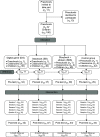Nutrition education strategies to promote vegetable consumption in preschool children: the Veggies4myHeart project
- PMID: 34702425
- PMCID: PMC9991745
- DOI: 10.1017/S1368980021004456
Nutrition education strategies to promote vegetable consumption in preschool children: the Veggies4myHeart project
Abstract
Objective: To test the efficacy of three nutrition education strategies on the intake of different vegetables in preschool children.
Design: This is an experimental study conducted in four Portuguese preschools. The intervention consisted of 20-min educational sessions, once a week, for 5 weeks, with one of the following randomised educational strategies: Portuguese Food Wheel Guide (control), digital game, storybook, storybook and reward (stickers). All groups had repeated exposure to vegetables in all sessions. A pre- and post-test were conducted to determine vegetable intake, and a 6-month follow-up was realised.
Setting: Preschools of Leiria district, Portugal.
Participants: A sample of 162 children aged 3 to 6 years. All eligible children attending the preschools were invited to participate.
Results: All interventions tested were effective in increasing vegetable consumption both in the short and medium term, without statistically significant differences, compared to the control group. Stickers were more effective in the short term than in the medium term.
Conclusions: The nutritional education strategies associated with repeated exposure tested in this study were effective in promoting vegetable consumption in preschool children. The use of stickers may be a valid strategy to promote the consumption of vegetables less recognised by children.
Keywords: Child; Health education; Preschool; Vegetables; Video games.
Figures
References
-
- Schwarzenberg SJ & Georgieff MK (2018) Advocacy for improving nutrition in the first 1000 d to support childhood development and adult health. Pediatrics 141, e20173716. - PubMed
-
- Rodriguez-Casado A (2014) The health potential of fruits and vegetables phytochemicals: notable examples. Crit Rev Food Sci Nutr 56, 1097–1107. - PubMed
-
- Nekitsing C, Blundell-Birtill P, Cockroft JE et al. (2019) Increasing intake of an unfamiliar vegetable in preschool children through learning using storybooks and sensory play: a cluster randomized trial. J Acad Nutr Diet 119, 2014–2027. - PubMed
-
- Lopes C, Torres D, Oliveira A et al. (2017) The National Food, Nutrition and Physical Activity Survey. Porto: University of Porto.
Publication types
MeSH terms
LinkOut - more resources
Full Text Sources



